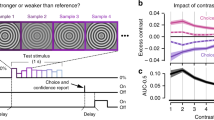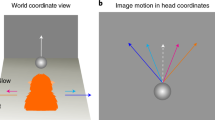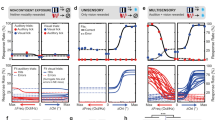Abstract
The neural mechanism underlying simple perceptual decision-making in monkeys has been recently conceptualized as an integrative process in which sensory evidence supporting different response options accumulates gradually over time. For example, intraparietal neurons accumulate motion information in favor of a specific oculomotor choice over time. It is unclear, however, whether this mechanism generalizes to more complex decisions that are based on arbitrary stimulus-response associations. In a task requiring arbitrary association of visual stimuli (faces or places) with different actions (eye or hand-pointing movements), we found that activity of effector-specific regions in human posterior parietal cortex reflected the 'strength' of the sensory evidence in favor of the preferred response. These regions did not respond to sensory stimuli per se but integrated sensory evidence toward the decision outcome. We conclude that even arbitrary decisions can be mediated by sensory-motor mechanisms that are completely triggered by contextual stimulus-response associations.
This is a preview of subscription content, access via your institution
Access options
Subscribe to this journal
Receive 12 print issues and online access
$209.00 per year
only $17.42 per issue
Buy this article
- Purchase on Springer Link
- Instant access to full article PDF
Prices may be subject to local taxes which are calculated during checkout








Similar content being viewed by others
References
Tversky, A. & Kahneman, D. The framing of decisions and the psychology of choice. Science 211, 453–458 (1981).
Heekeren, H.R., Marrett, S. & Ungerleider, L.G. The neural systems that mediate human perceptual decision making. Nat. Rev. Neurosci. 9, 467–479 (2008).
Shadlen, M.N. & Newsome, W.T. Motion perception: seeing and deciding. Proc. Natl. Acad. Sci. USA 93, 628–633 (1996).
Shadlen, M.N. & Newsome, W.T. Neural basis of a perceptual decision in the parietal cortex (area LIP) of the rhesus monkey. J. Neurophysiol. 86, 1916–1936 (2001).
Finney, D.J. Probit Analysis (Cambridge University Press, London, 1971).
McKee, S.P., Klein, S.A. & Teller, D.Y. Statistical properties of forced-choice psychometric functions: implications of probit analysis. Percept. Psychophys. 37, 286–298 (1985).
Astafiev, S.V. et al. Functional organization of human intraparietal and frontal cortex for attending, looking and pointing. J. Neurosci. 23, 4689–4699 (2003).
Connolly, J.D., Andersen, R.A. & Goodale, M.A. FMRI evidence for a 'parietal reach region' in the human brain. Exp. Brain Res. 153, 140–145 (2003).
Galletti, C., Fattori, P., Kutz, D. & Gamberini, M. Brain location and visual topography of cortical area V6A in the macaque monkey. Eur. J. Neurosci. 11, 575–582 (1999).
Snyder, L.H., Batista, A.P. & Andersen, R.A. Coding of intention in the posterior parietal cortex. Nature 386, 167–170 (1997).
Sereno, M.I., Pitzalis, S. & Martinez, A. Mapping of contralateral space in retinotopic coordinates by a parietal cortical area in humans. Science 294, 1350–1354 (2001).
Colby, C.L., Duhamel, J.R. & Goldberg, M.E. Visual, presaccadic and cognitive activation of single neurons in monkey lateral intraparietal area. J. Neurophysiol. 76, 2841–2852 (1996).
Bruce, C.J. & Goldberg, M.E. Primate frontal eye fields. I. Single neurons discharging before saccades. J. Neurophysiol. 53, 603–635 (1985).
Paus, T. Location and function of the human frontal eye-field: a selective review. Neuropsychologia 34, 475–483 (1996).
Heekeren, H.R., Marrett, S., Bandettini, P.A. & Ungerleider, L.G. A general mechanism for perceptual decision-making in the human brain. Nature 431, 859–862 (2004).
Heekeren, H.R., Marrett, S., Ruff, D.A., Bandettini, P.A. & Ungerleider, L.G. Involvement of human left dorsolateral prefrontal cortex in perceptual decision making is independent of response modality. Proc. Natl. Acad. Sci. USA 103, 10023–10028 (2006).
Shulman, G.L. et al. Common blood flow changes across visual tasks. II. Decreases in cerebral cortex. J. Cogn. Neurosci. 9, 648–663 (1997).
Raichle, M.E. et al. Inaugural article: a default mode of brain function. Proc. Natl. Acad. Sci. USA 98, 676–682 (2001).
McKiernan, K.A., Kaufman, J.N., Kucera-Thompson, J. & Binder, J.R. A parametric manipulation of factors affecting task-induced deactivation in functional neuroimaging. J. Cogn. Neurosci. 15, 394–408 (2003).
Weissman, D.H., Roberts, K.C., Visscher, K.M. & Woldorff, M.G. The neural bases of momentary lapses in attention. Nat. Neurosci. 9, 971–978 (2006).
Toth, L.J. & Assad, J.A. Dynamic coding of behaviorally relevant stimuli in parietal cortex. Nature 415, 165–168 (2002).
Freedman, D.J. & Assad, J.A. Experience-dependent representation of visual categories in parietal cortex. Nature 443, 85–88 (2006).
Stoet, G. & Snyder, L.H. Single neurons in posterior parietal cortex of monkeys encode cognitive set. Neuron 42, 1003–1012 (2004).
Snyder, L.H., Batista, A.P. & Andersen, R.A. Intention-related activity in the posterior parietal cortex: a review. Vision Res. 40, 1433–1441 (2000).
Silver, M.A., Ress, D. & Heeger, D.J. Topographic maps of visual spatial attention in human parietal cortex. J. Neurophysiol. 94, 1358–1371 (2005).
Schluppeck, D., Glimcher, P. & Heeger, D.J. Topographic organization for delayed saccades in human posterior parietal cortex. J. Neurophysiol. 94, 1372–1384 (2005).
Jack, A.I. et al. Changing human visual field organization from early visual to extra-occipital cortex. PLoS ONE 2, e452 (2007).
Cui, H. & Andersen, R.A. Posterior parietal cortex encodes autonomously selected motor plans. Neuron 56, 552–559 (2007).
Calton, J.L., Dickinson, A.R. & Snyder, L.H. Non-spatial, motor-specific activation in posterior parietal cortex. Nat. Neurosci. 5, 580–588 (2002).
Dickinson, A.R., Calton, J.L. & Snyder, L.H. Nonspatial saccade-specific activation in area LIP of monkey parietal cortex. J. Neurophysiol. 90, 2460–2464 (2003).
Kim, J.-N. & Shadlen, M.N. Neural correlates of a decision in the dorsolateral prefrontal cortex of the macaque. Nat. Neurosci. 2, 176–185 (1999).
Coles, M.G.H., Gratton, G., Bashore, T.R., Eriksen, C.W. & Donchin, E. A psychophysiological investigation of the continuous flow model of human information processing. J. Exp. Psychol. Hum. Percept. Perform. 11, 529–553 (1985).
Shadlen, M.N., Kiani, R., Hanks, T.D. & Churchland, A.K. Neurobiology of decision making: an intentional framework. in Better Than Conscious? Decision Making, the Human Mind, and Implications for Institutions (eds Engel, C, & Singer, W.) 71–101 (MIT Press, Cambridge, 2008).
Wilson, M. Six views of embodied cognition. Psychon. Bull. Rev. 9, 625–636 (2002).
Rorie, A.E. & Newsome, W.T. A general mechanism for decision-making in the human brain? Trends Cogn. Sci. 9, 41–43 (2005).
Kelley, W.M. et al. Hemispheric specialization in human dorsal frontal cortex and medial temporal lobe for verbal and nonverbal memory encoding. Neuron 20, 927–936 (1998).
Corbetta, M. et al. A functional MRI study of preparatory signals for spatial location and objects. Neuropsychologia 43, 2041–2056 (2005).
Epstein, R. & Kanwisher, N. A cortical representation of the local visual environment. Nature 392, 598–601 (1998).
Boynton, G.M., Engel, S.A., Glover, G.H. & Heeger, D.J. Linear systems analysis of functional magnetic resonance imaging in human V1. J. Neurosci. 16, 4207–4221 (1996).
Ollinger, J.M., Shulman, G.L. & Corbetta, M. Separating processes within a trial in event-related functional MRI I. The method. Neuroimage 13, 210–217 (2001).
Ollinger, J.M. & McAvoy, M.P. A homogeneity correction for post-hoc ANOVAs in fMRI. Neuroimage 11, S604 (2000).
Van Essen, D.C.A. Population-average, landmark- and surface-based (PALS) atlas of human cerebral cortex. Neuroimage 28, 635–662 (2005).
Van Essen, D.C. et al. Mapping visual cortex in monkeys and humans using surface-based atlases. Vision Res. 41, 1359–1378 (2001).
Acknowledgements
We are grateful to E. Lombardi for her assistance in data collection. We also thank C. Lewis and C. Sestieri for technical support on data analysis, and A. Snyder, M. McAvoy and E. Akbudak for software and hardware development. This work was supported by the EU FP6-MEXC-CT-2004-006783 project (Investigations in Brain Sciences Education Network), US National Institute of Mental Health grant R01MH71920-06 and US National Institutes of Health grant NS48013 to M.C., by Italian Ministry of University and Research grant PRIN 2005119851_004 to G.G., and by the 3rd Ph.D. Internationalization Program of the Italian Ministry of University and Research.
Author information
Authors and Affiliations
Contributions
A.T., G.G. and M.C. were involved in experimental design. A.T. was responsible for data acquisition and data analysis, and A.T., G.G., G.L.R. and M.C. were involved in data interpretation and writing the manuscript.
Corresponding author
Supplementary information
Supplementary Text and Figures
Supplementary Figure 1 and Supplementary Methods (PDF 323 kb)
Rights and permissions
About this article
Cite this article
Tosoni, A., Galati, G., Romani, G. et al. Sensory-motor mechanisms in human parietal cortex underlie arbitrary visual decisions. Nat Neurosci 11, 1446–1453 (2008). https://doi.org/10.1038/nn.2221
Received:
Accepted:
Published:
Issue Date:
DOI: https://doi.org/10.1038/nn.2221
This article is cited by
-
Proprioceptive short-term memory in passive motor learning
Scientific Reports (2023)
-
Making decisions about health information on social media: a mouse-tracking study
Cognitive Research: Principles and Implications (2022)
-
Lower visual field preference for the visuomotor control of limb movements in the human dorsomedial parietal cortex
Brain Structure and Function (2021)
-
Neural Networks Mediating Perceptual Learning in Congenital Blindness
Scientific Reports (2020)
-
Properties and temporal dynamics of choice- and action-predictive signals during item recognition decisions
Brain Structure and Function (2020)



